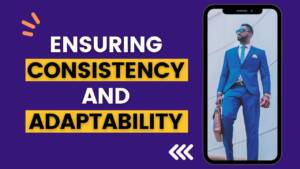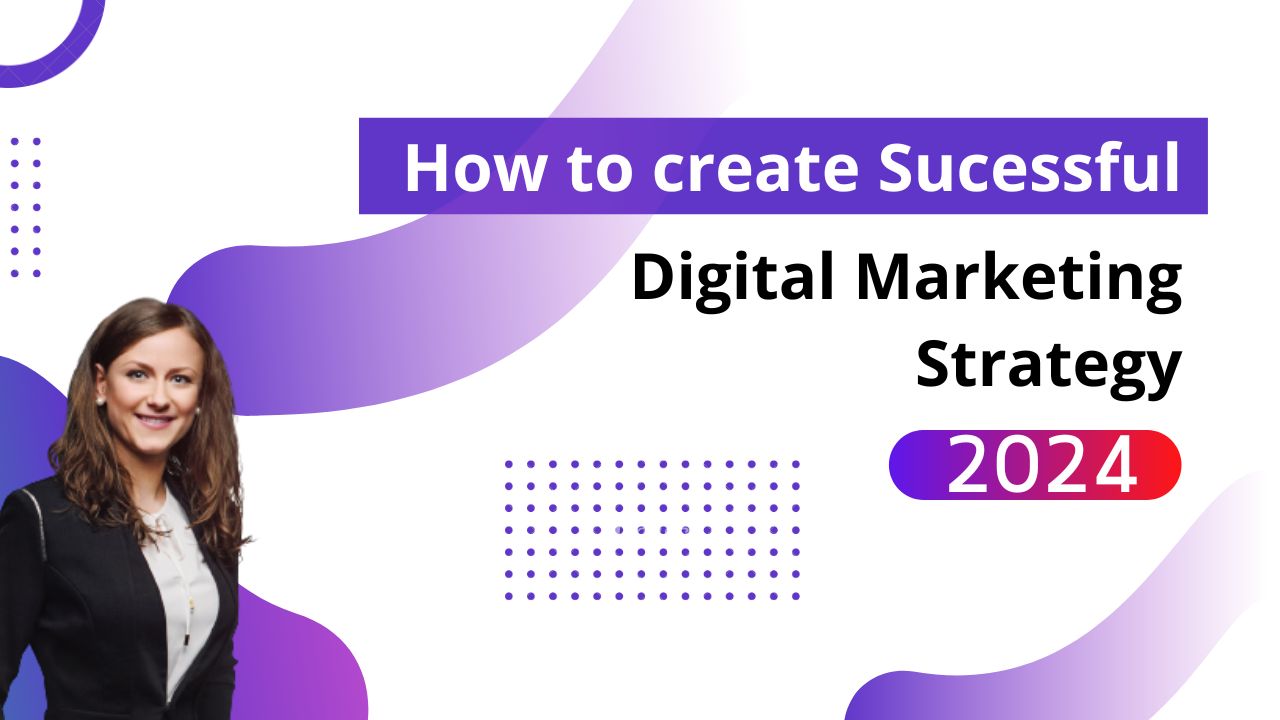Mastering Digital Marketing Strategy
In this article, you will learn about the digital marketing strategy for 2024. Well, marketing strategies depend on the businesses, and different strategies work for different businesses. The right marketing strategy can boost your brand visibility and brand engagement.
Objectives and Market Research
Setting clear objectives and conducting thorough market research are foundational steps for success. Let’s embark on a journey to understand how these two pillars work hand in hand to guide your endeavours.
Define SMART Goals
Before starting your digital marketing journey, it’s crucial to set specific, measurable, achievable, relevant, and time-bound (SMART) goals. Whether your objectives include increasing brand awareness, driving website traffic, or boosting sales, having clearly defined goals provides a comprehensive roadmap for your strategy.
- Specific: Imagine you want a big box of colourful candies. Instead of saying, “I want some candy,” you say, “I want a big box of red, blue, and green candies.” That’s being specific – knowing exactly what you want.
- Measurable: Now, let’s talk about how much candy you want. Instead of saying, “I want a lot,” you say, “I want 10 candies.” That’s measurable – you can count them.
- Achievable: Think about whether your goal is doable. If you say, “I want a whole candy store,” that might be too much. But saying, “I want a big box of candies from the store,” that’s doable and achievable.
- Relevant: Your goal should make sense. If you’re on a treasure hunt for candies, asking for a new toy doesn’t match. So, your goal should be relevant to what you’re trying to do.
- Time-Bound: Lastly, let’s talk about time. Saying, “I want candies someday” isn’t as good as saying, “I want candies by the end of the day.” That’s time-bound – it has a deadline.
Conduct Market Research
In the world of digital marketing, knowledge is power. Invest time into market research to understand your target audience, analyze competitors, and identify industry trends. Using tools like Google Analytics, social media insights, Google Trends, and Ahrefs keyword research to gain valuable Trending topics and data-driven insights.
Step 1: Know Your Questions Imagine you have a big puzzle, and each piece is a question. What do you want to know? Who likes your toys or candies? What do they like about them? Write down your questions – those are your puzzle pieces.
Step 2: Talk to People You know how you ask your friends what games they like? That’s talking to people! Go to your friends, your family, or even people in the park. Ask them your puzzle questions. Listen carefully – their answers are like clues!
Step 3: Look Around Just like when you look around for your lost toy, look around the neighbourhood or the internet. Check out other toy stores or candy shops. What are they doing? Are they doing something cool that you might want to try?
Step 4: Use Your Detective Tools Your detective tools are like the computer or the library. Search online for information. Look at pictures, and read stories – it’s like finding pieces of your puzzle in a book.
Step 5: Organize Your Findings Once you have all your clues, organize them. What did people say? What did you see? Put them together like pieces of a puzzle. This is your big picture – it helps you understand what’s happening.
Step 6: Make Smart Decisions Now that you have your big picture, you can make smart choices. If everyone likes a certain type of toy, maybe you want to have that in your store. If people like a specific flavour of candy, maybe you should have that too. It’s like using your detective skills to make your store the best!
Unique Selling Proposition (USP)
Identify your Unique Selling Proposition (USP)—the features that make your products or services stand out in the market. Understanding your USP is important for crafting compelling and targeted marketing messages.
Build Detailed Buyer Personas
Create detailed buyer personas to gain a deeper understanding of your target demographic, age, and interests. Understand their pain points, preferences, and online behaviour. This information can help you customize your digital marketing methods so that they efficiently reach your target demographic.
1. Give Your Persona a Name:
Think of a fun name for your persona, like “Joyful Jamie” or “Sweet Tooth Sammy.” This makes it feel like a real person.
2. Describe Their Personality:
Imagine your persona’s personality. Is Joyful Jamie super energetic and loves outdoor games? Is Sweet Tooth Sammy a bit shy but adores trying every candy flavour?
3. Age and gender:
Decide how old your persona is and whether they are a boy or a girl. Maybe Joyful Jamie is 8 years old and Sweet Tooth Sammy is a teenager.
4. Hobbies and Interests:
Think about what your persona likes to do. Does Joyful Jamie enjoy drawing and playing with action figures? Is Sweet Tooth Sammy into video games and reading comics?
5. Family and friends:
Consider who is in their family. Does Joyful Jamie have siblings who also love toys? Is Sweet Tooth Sammy always sharing candy with friends?
6. Where They Hang Out:
Imagine the favourite places of your persona. Does Joyful Jamie love the park or the playground? Does Sweet Tooth Sammy enjoy spending time at the candy store?
7. Challenges and Goals:
Think about what challenges your persona might face and what they dream about. Does Joyful Jamie want a new superhero toy? Does Sweet Tooth Sammy dream of trying every candy in the world?
8. How They Use Technology:
Consider if your persona uses phones, tablets, or computers. Maybe Joyful Jamie likes watching toy unboxing videos, while Sweet Tooth Sammy follows candy influencers on social media.
9. Shopping Habits:
Imagine how they shop. Does Joyful Jamie visit toy stores with parents? Does Sweet Tooth Sammy explore candy shops after school?
10. What They Value:
Think about what matters to your persona. Is Joyful Jamie all about fun and adventure? Does Sweet Tooth Sammy appreciate unique and exotic candy flavours?
Now you have your buyer persona—detailed characters that represent the awesome people who might love what you offer. Knowing them helps you make your store or candy shop even more fantastic for your customers!
Building a Strong Online Presence

In the vast world of the internet, having a strong online presence is like turning on a bright spotlight for your business or brand. To achieve this, mastering the art of SEO (Search Engine Optimization) is your secret weapon. Let’s explore how you can illuminate your digital space with effective SEO strategies.
The Power of SEO
SEO is like a magic spell for your website, making it more visible to people searching on search engines like Google. By optimizing your website, you increase the chances of appearing at the top when someone looks for something related to what you offer.
Key SEO Strategies to Boost Your Online Presence:
- Relevant Keywords:
- Think of keywords as secret codes that connect your website to what people are searching for. Choose words or phrases related to your business that your customers might type into a search engine.
- High-Quality Content:
- Imagine your website is a storybook, and each page is a different chapter. Fill those pages with interesting and helpful information. This not only keeps visitors happy but also tells search engines that your site is valuable.
- User-Friendly Experience:
- Make your website a comfy and easy-to-navigate place. Just like arranging toys neatly on shelves, organize your website so visitors can find what they need without getting lost.
- Regular Updates:
- Think of your website like a garden. Regularly watering it with fresh content and updates helps it grow. Search engines love to see that your site is alive and kicking, not stuck in the past.
- Reflect industry developments:
- Imagine your website is a superhero who needs to stay updated on the latest villains and gadgets. Reflecting industry developments keeps your content relevant and shows that you’re on top of your game.
- Consistent Web Presence:
- Imagine your online presence as a superhero signal shining in the sky. Be consistent in posting on social media, updating your blog, and engaging with your audience. This tells search engines that you’re active and trustworthy.
Website Auditing
Perform an in-depth inspection of your website to find and address any problems with its performance. Measure page load times, mobile responsiveness, and the overall user experience. A well-optimized website is an essential component of effective digital marketing.
1. Evaluate User Experience:
- Navigation: Check if your website is easy to navigate. Ensure that visitors can find what they’re looking for without confusion.
- Mobile-Friendliness: Test how your site looks and functions on different devices, especially on mobile phones.
2. Content Quality Check:
- Relevance: Ensure your content aligns with your business goals. Remove outdated information and update where necessary.
- SEO Optimization: Review content for proper use of keywords and metadata. Ensure that each page serves a specific purpose.
3. Technical Performance:
- Page Loading Speed: A slow website can turn visitors away. Use tools to check and improve your page loading speed.
- Broken Links: Identify and fix any broken links. Broken links can harm your SEO and frustrate visitors.
4. SEO Health Check:
- Keyword Analysis: Assess your keyword strategy. Are you targeting the right keywords for your business?
- Backlinks: Examine the quality and relevance of your backlinks. Disavow any harmful links and build new, valuable ones.
5. Security Measures:
- SSL Certificate: Ensure your website has an SSL certificate to secure data transmission. A secure site builds trust with visitors.
- Regular Backups: Implement a backup system to safeguard your data. Regular backups prevent potential data loss.
6. Conversion Optimization:
- CTAs (Call to Action): Evaluate the effectiveness of your CTAs. Are they clear, compelling, and strategically placed?
- Forms and Opt-ins: Check the functionality of forms and opt-ins. Ensure they capture leads seamlessly.
7. Analytics Review:
- Traffic Analysis: Use analytics tools to understand your website traffic. Identify popular pages, user behaviour, and areas for improvement.
- Conversion Tracking: Set up conversion tracking to measure the success of your goals, such as form submissions or product purchases.
8. Accessibility Check:
- ADA Compliance: Ensure your website is accessible to people with disabilities. This includes providing alternative text for images and ensuring compatibility with screen readers.
9. Social Media Integration:
- Link Integrity: Confirm that your social media links are working correctly. Social media integration enhances your online presence.
10. Future Planning:
- Scalability: Assess your website’s scalability. Is it ready to accommodate growth and future updates?
- Emerging Trends: Stay informed about current web design trends and technologies. Plan for updates to keep your website fresh.
Content is King
Compelling content is the lifeblood of digital marketing. Craft engaging and shareable content across diverse platforms. Whether it’s blog posts, infographics, or videos, focus on quality and relevance. Integrate long-tail keywords strategically to enhance your search engine ranking.
1. Authority and Trustworthiness:
- Just as a wise ruler earns the trust of their subjects, high-quality content establishes your authority in your field. When your content is informative, accurate, and well-researched, it builds trust with your audience.
2. Engagement and Connection:
- Engaging content is like a charismatic leader that captivates the hearts of the people. Whether it’s a compelling story, an insightful article, or an entertaining video, engaging content creates a connection with your audience, fostering loyalty and interest.
3. Search Engine Royalty:
- Search engines, the digital kingdoms, prioritize content relevance and quality. By offering valuable and relevant information, your content can ascend the search engine rankings, ensuring your digital kingdom is easily discoverable by those seeking your expertise.
4. Adaptability and Versatility:
- Like a flexible ruler who adapts to changing times, content can take various forms – articles, blogs, videos, infographics, and more. This versatility allows you to cater to diverse audience preferences, ensuring your message reaches far and wide.
5. Building Brand Identity:
- Your content is the storyteller of your brand. It weaves a narrative that shapes perceptions and defines your identity. Consistent and compelling content strengthens your brand, making it memorable and distinguishable in the crowded digital landscape.
6. Social Media Sovereignty:
- In the kingdom of social media, content rules. Shareable, relatable, and valuable content becomes the currency of engagement. It prompts likes, shares, and comments, amplifying your reach and influence.
7. Educational Empowerment:
- Knowledge is power, and content serves as the educator in the online realm. By providing valuable information, insights, and solutions, your content empowers your audience, positioning your brand as a reliable source of expertise.
Invest in Visual Content
In the digital era, visual content holds immense power. Invest in high-quality images, videos, and infographics to complement your written content. Visuals not only enhance user engagement but also contribute to a memorable brand image.
1. Visual Appeal Captivates Audiences:
- Just as a captivating painting draws admirers, visually appealing content captures the attention of online audiences. High-quality images, graphics, and videos stand out amidst the sea of information, making your brand memorable.
2. Enhances Brand Identity:
- Visual elements are the brushstrokes that shape your brand’s identity. Consistent use of colors, fonts, and design elements in visual content strengthens brand recognition, fostering a cohesive and memorable image.
3. Communicates Complex Ideas Effectively:
- Visuals are like universal languages. They transcend barriers and convey complex ideas in a concise and easily understandable manner. Infographics, charts, and diagrams turn intricate concepts into visual narratives.
4. Boosts Engagement on Social Platforms:
- In the social media kingdom, where users scroll through vast content landscapes, visual content reigns supreme. Posts with eye-catching visuals receive higher engagement, shares, and comments, amplifying your brand’s reach.
5. Video Content: The Crown Jewel:
- Video content sits atop the digital throne. Whether it’s a product demo, a behind-the-scenes glimpse, or storytelling, videos engage audiences like no other medium. Investing in video production establishes a dynamic and interactive connection with your audience.
6. Supports SEO Strategies:
- Search engines appreciate visual content. Images and videos, when properly optimized with descriptive alt text and tags, enhance your website’s SEO. This, in turn, improves your chances of being discovered in search engine results.
7. Creates Shareable Moments:
- A visually stunning image or an entertaining video becomes a shareable moment. User-generated content, such as photos of your products or customers sharing their experiences, transforms your audience into brand advocates.
8. Evokes Emotional Responses:
- Visuals have the power to evoke emotions. Whether it’s joy, nostalgia, or inspiration, images and videos create a visceral connection with your audience, fostering a positive perception of your brand.
9. Adaptability Across Platforms:
- Visual content adapts seamlessly to various digital platforms. Whether it’s for your website, social media channels, email campaigns, or presentations, investing in visual content ensures a versatile and consistent brand representation.
10. Future-Proofing Your Strategy:
- As digital trends evolve, visual content remains a constant. Embracing new visual storytelling techniques and technologies ensures that your brand stays relevant and continues to engage the ever-evolving digital audience.
Implement a Content Calendar
A well-structured content calendar ensures consistency in your content creation efforts. Plan and schedule your content in advance, taking into account key events, holidays, and industry trends. This approach ensures a steady flow of relevant and timely content.
1. Define Your Goals:
- Just like planning a journey, start by defining your destination. What are your content marketing goals? Is it to increase brand awareness, drive website traffic, or boost engagement on social media? Knowing your goals guides your content creation.
2. Know Your Audience:
- Understanding your audience is like knowing who your fellow travelers are. What do they like? What problems do they want to solve? Tailor your content to meet their needs and preferences.
3. Choose Your Platforms:
- Different platforms are like different stops on your journey. Identify the platforms where your audience is most active – whether it’s your blog, social media, email newsletters, or other channels.
4. Develop a Content Mix:
- Variety keeps your journey exciting. Plan a mix of content types – articles, videos, infographics, and more. This ensures your audience stays engaged and your message is conveyed in diverse ways.
5. Establish a Posting Schedule:
- Consistency is your travel companion. Decide how often you’ll post content. Whether it’s daily, weekly, or bi-weekly, having a set schedule helps manage expectations and keeps your audience anticipating your next move.
6. Use Tools and Platforms:
- Tools are like navigation aids. Use content management platforms or social media scheduling tools to plan and automate your posts. This saves time and ensures timely delivery.
7. Content Themes and Categories:
- Themes are like the themes of different destinations on your journey. Plan content around specific themes or categories to maintain coherence and cater to different aspects of your audience’s interests.
8. Collaborate and Assign Responsibilities:
- Just as group travel involves collaboration, if you have a team, assign responsibilities. Who’s in charge of content creation, who handles social media, and who oversees analytics? Clear roles prevent confusion.
9. Plan for Seasonal and Trend-Relevant Content:
- Seasons and trends are like special events on your journey. Plan content around holidays, events, or current trends to stay relevant and capture your audience’s attention.
10. Regularly evaluate and Adjust:
- A journey isn’t always predictable. Regularly review your content performance. What worked well? What needs adjustment? Adapt your content calendar based on your analytics and audience feedback.
The Power of Social Media

Social media platforms are not just places to connect; they are dynamic marketing channels with vast potential. Developing a comprehensive social media strategy can unlock this potential, allowing you to achieve your goals, connect with your target audience, and boost brand visibility.
Develop a Social Media Strategy
Social media platforms are not just tools for connection; they are powerful marketing channels. Develop a comprehensive social media strategy outlining your goals, target audience, and content calendar. Tailor your content for each platform, recognizing the unique characteristics of platforms like Facebook, Instagram, Twitter, and LinkedIn.
Utilize Social Listening
Social listening involves monitoring online conversations to gain insights into customer sentiments and industry trends. Leverage tools to track mentions of your brand, products, and industry keywords. This valuable data can inform your content strategy and customer engagement efforts.
Harness the Power of User-generated Content
Encourage your audience to generate content related to your brand. User-generated content not only builds community engagement but also serves as authentic testimonials. Feature user-generated content on your platforms to strengthen brand loyalty.
Paid Advertising

Paid advertising is a potent tool in the digital marketing arsenal, capable of delivering substantial results when wielded with precision and strategy. Here’s a guide on how to leverage paid advertising effectively, ensuring your campaigns reach the right audience and yield optimal outcomes.
Precision in Paid Campaigns
Paid advertising, when executed strategically, can yield significant results. Leverage platforms like Google Ads and social media advertising to target specific demographics. Utilize retargeting strategies to re-engage potential customers who have shown interest in your products or services.
- Strategic Platform Utilization:
- Choose your advertising platforms wisely. Google Ads and social media advertising (such as Facebook, Instagram, Twitter, and LinkedIn) offer robust targeting options. Understand the demographics and behavior of your audience on each platform to tailor your approach.
- Targeting Specific Demographics:
- Define your audience parameters meticulously. To ensure that those who are most likely to be interested in your products or services see your ads, use the targeting tools offered by advertising platforms to target specific groups of people.
- Retargeting Strategies:
- Implement retargeting to re-engage potential customers who have previously shown interest in your offerings. By strategically displaying ads to users who have visited your website, you stay in their consideration set and increase the likelihood of conversion.
Implement A/B Testing
Optimize your paid campaigns through A/B testing. Experiment with different ad creatives, copy, and audience targeting. Analyze the results to refine your campaigns continuously. A/B testing ensures that your advertising efforts are data-driven and effective.
- Optimizing Ad Components:
- A/B testing is your key to refining and optimizing paid campaigns. Experiment with different elements such as ad creatives, copy, and audience targeting to identify what resonates best with your audience.
- Data-Driven Refinement:
- Analyze the results of A/B tests meticulously. Use the data obtained to refine your campaigns continuously. This data-driven approach ensures that your advertising efforts are not only effective but also adaptable to the evolving preferences of your audience.
Explore Remarketing Opportunities
Implement dynamic remarketing to personalize ads based on users’ past interactions with your website. This targeted approach enhances the chances of converting potential leads into customers. Leverage remarketing to stay top-of-mind with your audience.
- Dynamic Remarketing:
- Personalize your ads with dynamic remarketing based on users’ interactions with your website. Showcase products or services that users have previously viewed, creating a more tailored and enticing ad experience.
- Staying Top-of-Mind:
- Leverage remarketing to stay top-of-mind with your audience. Even after they leave your website, dynamic remarketing ensures your brand remains visible as users browse other sites or platforms.
Analytics: The North Star of Optimization
analytics serves as the guiding North Star, providing essential insights for refining strategies and achieving optimal results. Beyond basic metrics, the integration of advanced analytics tools is key to unravelling the intricacies of user behaviour, conversion paths, and attribution models.
Implement Advanced Analytics Tools
Beyond basic metrics, leverage advanced analytics tools to gain deeper insights into user behaviour, conversion paths, and attribution models. Implement tools like Google Analytics, Google Tag Manager, and heatmaps to refine your strategies based on robust data.
- Deeper Insights with Google Analytics:
- Utilize Google Analytics to go beyond surface-level metrics. Dive deep into user interactions, track conversion funnels, and gain a comprehensive understanding of how visitors engage with your website. Uncover valuable data to inform strategic decisions.
- Enhanced Tracking with Google Tag Manager:
- Implement Google Tag Manager for streamlined tracking implementation. This tool allows you to manage and deploy various tags, ensuring accurate data collection without the need for constant code adjustments. It simplifies the tracking process and enhances data accuracy.
- User Experience Analysis with Heatmaps:
- Heatmaps provide a visual representation of user interactions on your website. By analyzing where users click, scroll, or spend the most time, you gain insights into user behavior and preferences. This information is invaluable for optimizing website design and content placement.
Conduct Regular SWOT Analyses
Periodically conduct Strengths, Weaknesses, Opportunities, and Threats (SWOT) analyses to evaluate your digital marketing performance. Identify areas for improvement, capitalize on strengths, and stay ahead of emerging opportunities and potential threats in the market.
- Evaluate Strengths:
- Identify and capitalize on your strengths. Analyze what sets your digital marketing efforts apart, whether it’s a robust social media presence, compelling content, or a seamless user experience on your website.
- Address Weaknesses:
- An honest evaluation of weaknesses is crucial. Whether it’s gaps in your content strategy, issues with website performance, or challenges in audience engagement, addressing weaknesses is essential for continuous improvement.
- Explore Opportunities:
- Stay vigilant for emerging opportunities in the digital landscape. Trends, new technologies, or shifts in the consumer behaviour can present growth opportunities. Being proactive allows you to capitalize on these openings.
- Mitigate Threats:
- Identify potential threats that could impact your digital marketing efforts. This could include changes in the competitive landscape, shifts in consumer preferences, or external factors affecting your industry. Mitigate these threats through strategic planning and adaptation.
Ensuring Consistency and Adaptability

In the ever-evolving landscape of digital marketing, striking a balance between consistency and adaptability is key to building a strong and resilient brand presence.
Consistent Branding Across Channels:
- Unified Brand Image:
- Maintain a consistent brand image across all digital channels. From your website to social media platforms, ensure that your logo, colours, and messaging align seamlessly. Consistency fosters trust and enhances brand recall.
- Cohesive Messaging:
- Deliver a cohesive message that resonates with your audience. Whether it’s a blog post, a social media update, or an email campaign, the messaging should reflect your brand’s values and personality consistently.
- Unified User Experience:
- Create a unified user experience. When a customer interacts with your brand on different platforms, they should experience a seamless and cohesive journey. Consistency in user experience contributes to positive brand perception.
Monitor Emerging Trends:
- Proactive Industry Awareness:
- Stay abreast of emerging trends in digital marketing. Regularly monitor industry publications, attend webinars, and participate in relevant forums. Being proactive in adopting emerging trends ensures your brand stays ahead of the curve.
- Adaptability to Change:
- Embrace a culture of adaptability. The digital landscape is dynamic, and trends evolve. Be ready to adjust your strategies and adopt new technologies or platforms that align with your brand goals.
- Incorporate Innovations:
- Integrate innovative solutions into your digital marketing approach. Whether it’s incorporating new tools, exploring interactive content formats, or experimenting with emerging platforms, innovation keeps your brand fresh and engaging.
Agile Response to Feedback:
- Encourage Customer Feedback:
- Actively seek customer feedback and reviews. Encourage your audience to share their thoughts and experiences with your brand. This not only engages customers but also provides valuable insights into their preferences.
- Prompt and Positive Responses:
- Respond promptly to feedback, both positive and negative. An agile response shows that you value customer input. Address concerns positively, turning negative experiences into opportunities for improvement and showcasing your commitment to customer satisfaction.
- Continuous Improvement:
- Use customer feedback as a catalyst for continuous improvement. Analyze patterns in feedback to identify areas for enhancement. This iterative process helps your brand evolve and better meet the expectations of your audience.
Creating a successful digital marketing strategy requires a holistic approach that blends creativity, data-driven decisions, and adaptability. From a robust SEO foundation to compelling content, strategic social media campaigns, precision in paid advertising, and advanced analytics, each element plays a crucial role. Stay vigilant, analyze data meticulously, and be agile in adapting to the ever-changing digital landscape. Success in the digital realm is not just a destination; it’s an ongoing journey of refinement and innovation.


